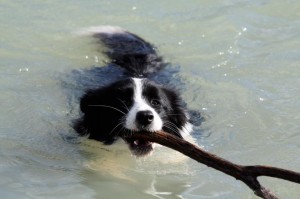This post is part of the McGreevy seminar series. Click here for the index.
McGreevy had a lot to say about rewarding dogs. Reward training is his preferred method of training for dogs.
Most importantly, to know what a dog wants and likes can help us in our training. Dogs value a range of things, and each can be used as reward. However, what a dog wants and likes varies in different contexts. McGreevy was big on appreciating animals as individuals in order to get the best out of them.
McGreevy believes in allowing dogs to pick their own rewards, and allow dogs to be ‘creative’ in their reward choice. The speed and strength of a dog’s learning can indicate how attractive the reward is.
Rewards can be innate (i.e. a primary reinforcer) or learned (i.e. a secondary reinforcer).
We can also influence the value of rewards. For example, if we play with a ball before we throw it, it may act as a greater reinforcer. Also, by fasting a dog, they have a higher drive for food.
He listed a number of things that could be used as reinforcers. They are what dogs consider to be resources, and so they value them and will work for them.

Fun, surprises, and play
Dogs like fun surprises, like unpredictable or concealed rewards. Dogs like the ‘fun’ of being rewarded with magically appearing stuff.
Dogs are opportunistic and playful. They like to play, and it can take time to play with dogs effectively (he mentioned Steve Austin as ‘great at playing with dogs’). Dogs can value each other as resources and play companions. (He mentioned Alexandra Horowitz book, Inside of a Dog, for more insights on dog play.)
McGreevy emphasised that, when playing with dogs, we need to avoid dogs putting teeth on humans. Chasing and using teeth are innately rewarding for dogs, and we need to prevent the opportunity for them to learn that humans are appropriate to chase and teeth.
Food
McGreevy called a bowl of dog food “a bowlful of training opportunities”. He did note that some people, however, are of them the mindset that it is ‘wrong’ to make dogs work for meals and instead the dogs should have an innate ability to please.
Other Rewards
Dogs, as a domesticated animal are social, so they can be rewarded with social interaction.
Some dogs can also be rewarded with exercise, training, water, sex, liberty, sanctuary, and comfort.
Personal Experiences
I have found so much diversity in my dogs and what they find rewarding. I think this has made me a better trainer, in having to work with dogs as individuals and not taking a ‘one size fits all’ approach.
With Clover I spent a lot of time with her to ensure that she would work well for both food and toys. She loves her tennis ball, but she sometimes gets over-aroused and stops thinking when training. For this reason, I normally use food rewards with her as it keeps her motivated but not over-aroused. She does, however, receive a tennis ball reward at the end of tracking.
Chip is a dog that I can reward with a pat, praise, and a cuddle. He likes food, and he likes toys, but he often gets over aroused with both of these rewards. For Chip, when we track, he has a reward of a cuddle and praise at the end of the track. He must like it, otherwise he wouldn’t track!
So do your dogs find rewarding? What are your more ‘creative’ rewards?
Further reading: Ian Dunbar on Reward Training Techniques
This post is part of the McGreevy seminar series. Click here for the index. Continue reading →



